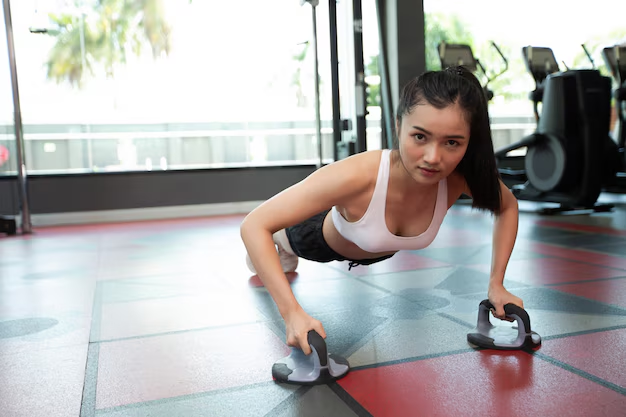For me, losing weight is always about making mistakes along the way. I always felt stressed and unclear of how to start with the number of fitness trends, diets, and workout plans that are available. However, all changed when I read about Chinese Exercise For Weight Loss I was struck by how old beliefs and the latest exercise routines were mixed.
They also helped my mental focus and balance as well as my physical health, which is something I did not have with before workouts. This site is for you if you've ever been excited about learning more about basic Chinese exercises. I'll be talking about the benefits of some exercises, my personal experience with them, and how you can start incorporating them into your routine at home or at the gym.
What Are the Best Chinese Exercises for Losing Weight?
Table of Contents
- An Overview of Chinese Weight Loss Exercise Plans
- Chinese exercise's benefits for losing weight
- Tai Chi and yoga are traditional Chinese exercise methods.
- "At-Home Chinese Workouts to Lose Weight"
- Benefits of the "Kiat Jud Dai Workout" for Losing Weight
- My Own Picks: The Best Chinese Exercises for Losing Weight
- Choosing a Routine: When Should You Practice?
- How to Burn Fat with Chinese Exercises
- My Experience: Results and Benefits
- Important lessons learned
Introduction to Chinese Exercise for Weight Loss
I had no idea Chinese exercise could be so successful in helping me lose weight when I first started my fitness journey. The goals of these workouts are to boost power, improve flexibility, and improve overall health.
The focus on balance and focus during such tasks really drew to me since it looked different from the difficult quick workouts I was used to. A lot of Chinese workouts are based on the idea of mind-body balance.
With this complete strategy, I was able to improve my mental wellbeing while losing weight. I find that using awareness, slow motion, and breathing exercises greatly lowers my stress levels, which helps weight loss feel less like a duty and more like a process of personal growth.
Read also: Jihyo Weight Loss Exercise
Benefits of Chinese Exercise for Weight Loss
The fact that Chinese exercise goes beyond simply burning calories is one of the key reasons I was drawn to it for weight loss. The benefits go way beyond that. The following is an overview of the main benefits:
- Improved Flexibility: My capacity improved as a result of doing It and Tai Chi, which also helped lower my chance of injury.
- Increased Strength: In spite of their evident slowness, these exercises work several muscle groups at the same time, adding power.
- Stress Reduction: After doing these exercises, I was able to relax and gain mental focus, which is important for weight loss because stress can lead to eating.
- Balance and Coordination: After regularly doing traditional Chinese exercises, I found that my motor skills had greatly improved—something I hadn't done with other types of training.
Traditional Chinese Exercise: Tai Chi and Qigong

The two main forms of traditional Chinese exercise are Qigong and Tai Chi. To be honest, when I first watched videos of Tai Chi users, I didn't think it would help people lose weight because it was too slow.
However, after giving yoga a shot, I learned that the careful, slow moves really work my core and other muscles in unexpected ways.
Tai Chi
Tai Chi is a kind of martial art that uses deep breathing and thinks about slow moves. regularly to "meditation in action. This practice helps to still the mind while using the body. I wasn't sure at first how yoga would aid in weight reduction, but after training daily for a few weeks, I saw changes in my flexibility and posture. I was also able to burn calories without getting tired.
Qigong
It, another traditional Chinese exercise, emphasizes the control of breath, movement, and focus in order to nurture life force, or Qi. It's more important to restore balance to the body than it is to lose weight in a typical way.
Still, I found that adding it to my daily routine helped lower stress and improve my overall health, which finally aided my weight loss goals.
"Chinese Workouts to Lose Weight at Home"

One of the best things about Chinese workouts is that they can simply be done at home. The workouts may be improved to match your area, and there's no need for costly fitness gear. Here's how I created my own at-home Chinese fitness plan to help me lose weight:
- Find a quiet space. Check that you have enough space to move around. Just enough to comfortably stretch your arms and legs will suffice.
- Set aside time: As I became more familiar with the workouts, I increased my daily time from the first 20 minutes to 45 minutes.
- Follow a routine: I found a wealth of online courses and videos that led me through beginner-specific Tai Chi and Yoga practices.
- Stay consistent: The key is to be steady! As I practiced more, I began to notice results.
The "Kiat Jud Dai Workout" and Its Role in Weight Loss
A less popular yet very powerful Chinese exercise that focuses flexibility and core strength is called Kiat Jud Dai. Compared to Tai Chi and Qigong, it moves more quickly, but it still uses breath control and meditation.
This workout added a little variety to my plan, which kept me focused and focused. I found it to be a beneficial balance to the slower workouts.
One of my main issues was stubborn belly fat, and the Kiat Jud Dai workout is wonderful for that. I was able to reduce the number of cm around my waist, all the while keeping my head steady and calm.
Read also: Compression Garments For Weight Loss
My Personal Favorites: The Best Chinese Exercises for Weight Loss

I've tried a lot of Chinese workouts to help me lose weight, and these are a few of my personal favorites:
- Tai Chi for Beginners: I would definitely recommend this to anyone who is new to Chinese exercise, as it is where I started. While actions are slow, they reinforce and improve balance.
- Qigong Breathing Exercises: These helped me in soothing, which is important to weight loss.
- The Kiat Jud Dai Workout: Ideal for anyone looking for a more challenging workout routine with increased awareness.
- Eight Brocades Qigong: This type of Qigong exercise is excellent for boosting internal health and softness, both of which finally result in weight loss.
Creating a Routine: How Often Should You Practice?
I wasn't sure when I needed doing Chinese workouts to Lose Weight to notice effects when I started adding it into my routine. Here's what I found to work after testing with several schedules and doing some research:
- Tai Chi: 3-4 times a week, for about 30-45 minutes.
- Qigong: For about 15-20 minutes per day, either in the morning or evening.
- Kiat Jud Dai: 2-3 times a week for a more intense workout, lasting about 20-30 minutes.
Thanks to this combo, I was able to avoid stress and maintain stability.
How to Get Started with Chinese Exercise for Weight Loss

arted out on the trip with some fair goals in mind. It's critical to practice patience and unity. Remember that losing weight is a slow process, so keeping your resolve is important.
Find a routine that works for you.
Explore different workouts to find your best fit. Before settling on a routine that I will keep and find fun, I tested with a variety of traditional and modern Chinese workouts.
Combine it with a balanced diet.
Weight loss cannot be done with exercise alone. I made sure to mix my Chinese workout routine with a balanced diet. In my weight loss quest, eating healthful foods and drinking lots of water have been helpful.
Create a routine.
For me, it was important to set up a regular exercise routine. I decided to set aside particular days for Kiat Jud Dai, Qigong, and Tai Chi exercises.
Find online resources.
Multiple free online courses and training are available! Finding guided sessions on multiple YouTube channels makes it simple to follow along at home.
Start Slow
I learned early on how crucial it is to go slowly. In the early stages, I didn't push myself too hard; instead, I focused on becoming excellent with the moves and methods.
Stay Consistent
Having stability is key to losing weight. I tried to work out three or four times a week at the very least. My strength and flexibility have changed greatly over time, I've noticed.
Read also: Torch Calories, Tone Up: Top Workouts for Women's Weight Loss
How Chinese Exercises Help Burn Calories

When I first started doing these workouts, I thought how they might aid in losing weight. Remarkably, for such slow motions, they use several different muscle groups and spend a lot of energy to execute well.
Tai Chi, for example, forces you to balance a lot, which means your core muscles are used all the time. Qigong is centered around mindful movements and deep breathing, which raises your heart rate and aids in fat burning.
My Experience: Results and Benefits

I've seen improvements in my health on both sides after doing Chinese exercises for weight loss for a few months. Along with losing weight, I also improved my strength, flexibility, and balance.
More significantly, I feel more at ease and in control than I have ever been. I was able to attain a balance that I was unable to find during past workouts because of the mix of Tai Chi, Qigong, and the Kiat Jud Dai routine.
Even though I've lost a lot of weight, what really motivates me to continue with these activities is the general sense of well-being I've acquired.
Key Takeaways
- Because it combines sport and focus, Chinese exercise is a powerful weight loss and stress-reduction method.
- Different levels of challenge are available in exercises like Tai Chi, Qigong, and the Kiat Jud Dai workout, which gives you freedom when creating a plan.
- These exercises don't require any extra tools and are ideal for home workouts.
- To get the best results, practice consistently—start small and build up your practice time over time.
- These activities not only help people lose weight but also improve flexibility, balance, and mental focus.
My view of fitness has changed as a result of such things as Chinese workouts to lose weight in my practice. It's an overall strategy for taking care of your body and mind, not just an exercise. I strongly advise doing these workouts if you're seeking a long-term, low-impact way to lose weight.
FAQ's: Chinese Exercise For Weight Loss
Is Chinese exercise effective for weight loss?
In fact! When done daily, the slow, think actions of Chinese Workouts to Lose Weight help improve flexibility, improve the body, and help with long-term weight loss.
Can I practice Chinese exercise at home?
Of course! By choosing a peaceful space, paying attention to how you feel, and according to a regular timetable, you can use Chinese workouts to lose weight at home with ease.
What are the best Chinese workouts to lose weight?
The finest Chinese exercises to lose weight are Tai Chi, Qigong, and the Kiat Jud Dai workout. They mix methods of fat-burning, strength-training, and mindfulness.
Is Chinese exercise good for weight loss?
Individuals with chronic conditions and healthy individuals can both benefit from Tai Chi exercise. The benefits of tai chi include: better sleep. reduction in weight.
Does the Chinese belly exercise work?
A personal trainer claimed that the movement was an inefficient strategy for reducing belly fat. According to Sohee Lee, a personal trainer, Janny makes promises in their videos that the workout can "reduce the abdomen," but it's untrue that you can focus fat loss on a particular body part.
Are Chinese exercises effective?
According to a recent study, there may be a Chinese fitness regimen that is superior to your standard moderate aerobic routines. You did really read correctly! The elegant martial art of tai chi, which is renowned for its slow, methodical movements, has become an unexpected rival in the fields of cardiovascular health and fitness.
